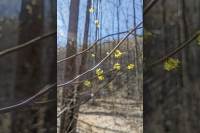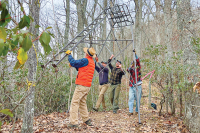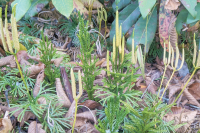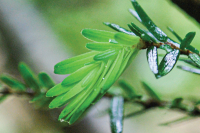Wild Vision: George Masa book pairs famed images with modern experiences
 George Masa sets up his camera during a 1931 trip to what is now the Shining Rock Wilderness. GSMA photo
George Masa sets up his camera during a 1931 trip to what is now the Shining Rock Wilderness. GSMA photo
The 1900s were just a few years along when a young man named Masahara Iizuka stepped on American soil for the first time. Around 26 years old, he’d arrived in California to pursue a career in engineering, having studied the subject at Meiji University back in Tokyo.
More than 100 years later, few people have heard of Masahara Iizuka, who never did become an engineer. But many people know the name George Masa, the identity Masahara later adopted. They also know his work — spectacular photos of the Southern Appalachians, a wild region on the cusp of change.
“It was just interesting to think about how intimate he was with a place like that,” said Brent Martin, author of the newly released book “George Masa’s Wild Vision: A Japanese Immigrant Imagines Western North Carolina.”
“I think that’s something most people would get from his photographs, is he was able to convey a certain intimacy with the landscape,” he added. “I really developed an appreciation of that, revisiting those places.”
In “George Masa’s Wild Vision” Martin, a poet, essayist and outdoorsman based in Cowee, pairs creative nonfiction inspired by visits to Masa’s old haunts with Masa’s crisp black-and-white landscape photography from the 1920s and 1930s. It’s an experiential ode, not a biography. Martin sees the work as an “interlude” between the 2019 Horace Kephart biography by George Ellison and Janet McCue — which also included research on Kephart’s dear friend Masa — and the Masa biography on which McCue and Paul Bonesteel, creator of the 2002 film “The Mystery of George Masa,” are currently collaborating, expected to publish in 2023.
“For me, it was more about, where are these places now? Where do these photographs take us? Where is the journey?” Martin said. “These places, 100 years later, where has it gone?”
Related Items
Art as advocacy
George Masa first came to North Carolina in 1915, landing a job in the laundry room of the new Grove Park Inn. Nobody knows how he learned photography or accessed the equipment and darkroom space needed to hone the skill, but by 1918 he had left the inn to join Pelton Studios in Asheville as a partner, taking over the photography business a year later and renaming it Plateau Studios.
Despite his origins on the opposite side of the globe, his broken English, and the growing anti-Asian sentiment of the day, Masa found camaraderie with a blossoming community of people who loved the mountains and fought to preserve them. Masa was a frequent hike leader with the Carolina Mountain Club and fast friends with Horace Kephart, with whom he worked to advocate for and explore the national park, and to define the southern route of the Appalachian Trail.
Photography was Masa’s livelihood, but even as he paid the bills with promotional shots, news photography and film processing, he kept his artistic side alive with long disappearances into the mountains. He always lugged his big box camera along, coming back with spectacular images of the most rugged and hard-to-photograph places east of the Mississippi.
“He was creating art, but he was creating advocacy at the same time,” said Martin. “I guess photographers are still doing that today, to what effect I don’t know, but I think his images were pretty important for that era, for the outcome of places like Mt. Mitchell and like Chimney Rock.”

- The Sawtooth Mountains and Mt. LeConte spread out from the view at Charlies Bunion. George Masa/Donated photo
When Masa arrived in Asheville, the vast swaths of land now protected in the Pisgah and Nantahala national forests were still in private ownership. The push to establish the Great Smoky Mountains National Park had yet to begin, and Benton MacKaye had not yet proposed the Appalachian Trail.
“The landscape was in the midst of a great transition then, and it was one based on resource extraction,” said Martin. “I think Masa and Kephart and many other people in the Southern Appalachians at the time were in the midst of the realization that this is going, going, gone — so how do we work like hell to get the park established and work like hell to get a national forest system stitched together? And they did.”
Past and present
When Martin first began talking with Hub City Press founders John Lane and Betsy Teter about doing a Masa book, it was 2019 and the COVID-19 pandemic had not yet changed daily life the world over. He signed the contract to produce the book shortly before lockdown set in.
When restrictions lifted that summer, Martin started going everywhere that Masa and his camera and been. Lockdown was over, but the pandemic was not — the fears and tensions that accompanied life in 2020 are present throughout Martin’s voyage.
“It was impossible not to think about America 100 years after George Masa and think about his life 100 years ago and what was going on in the South, and juxtaposing those two worlds as part of the book,” Martin said. “That was sort of my journey with the book.”
The first essay, about Martin’s hike to Masa Knob in July 2020, is printed alongside a photograph Masa took in the 1920s of two companions looking east from Newfound Gap. Today, one of the park’s most popular overlooks, Newfound Gap boasts an enormous parking lot, concrete sidewalks and the two-tiered stone Rockefeller Memorial honoring the biggest donor toward the park’s creation. When Masa was there, it was a gravel pullout on an unpaved road so primitive it wasn’t passable by car. Masa and Kephart tried but got stuck. The had to walk to a nearby Champion Fiber lumber camp to get help.
“We’re in the midst of global chaos today, but I rest in a sanctuary of wildly diverse and indifferent forest,” Martin writes as the narrative takes him to nearby Charlies Bunion. “After 10 or so minutes, the crowd subsides and I ease out to the outcrop. My view is to the north. Mount Kephart lies just to the west. To the southwest, Masa Knob, diminutive in comparison to the higher, more prominent Mount Kephart, lies softer, more rounded, and unobtrusive. Just to the southeast are the Sawteeth, a jagged length of ridgetop outcrop that Masa captured in power and light. His wish for his final resting place to be next to his close friend Horace Kephart was never realized, but perhaps this is close enough.”
The isolated mountains that Masa roved in the early 1900s are now home to the country’s most popular national park, with a record-breaking 14.1 million visits logged last year alone. For the first mile or so of Martin’s hike, a “constant stream of hikers” passed by, the trailhead crowded with families, groups of friends and one large group from a boys’ outdoor camp. Charlies Bunion is full of “numerous visitors drinking in the view and snapping smart-phone photos.”
It’s a striking comparison, Martin said — on one side, the lonely landscape of the past, capturable only through the skillful hands of an artist devoted enough to lug a cumbersome, heavy set of equipment to the ends of the earth. On the other, a well-traveled icon, photographed hundreds of times per day at the push of a button.
Some places, though, have taken the opposite journey. Three Forks, for example, a nearly inaccessible spot in the eastern part of the park that is still “one of the wildest places in the East,” is even wilder today than it was when Masa went there, Martin wrote. Unable to find the old manway Masa used, Martin and his wife failed on their first attempt to reach it.
“When we finally made it to Three Forks on our second attempt, I felt a sense of timelessness like I had never experienced before — the forest primeval, untouched by senseless modern human hands,” Martin wrote. “The place was fairy tale-like in its appearance, Jurassic in its feel.”
It was a startling contrast to Newfound Gap, now one of the most visited national park viewpoints in the country.

- Blasting debris from the road cut is visible down the slope and into the ravine in Masa's 1929 image of Cullasaja Falls. George Masa/Donated photo
While Masa is known mainly for his photography of the mountains that would one day become a national park, the Smokies comprises only one chapter of Martin’s 139-page book. As Martin began to research, he realized that Masa’s images were far more wide-ranging than he’d originally thought, capturing wild places from Chimney Rock and Mt. Mitchell to Shining Rock, the Nantahala River Valley, Highlands Plateau and Mt. Oglethorpe in Georgia. The chapter divisions reflect this diversity.
“For me it was, thank God there’s a deadline, because I could have just kept on with this book forever,” said Martin.
Century of change
Masa’s life was prolific but short. He died of tuberculosis in 1933, one year before the park was established, at about 51 years old. Neither he nor Kephart, who died two years earlier, saw their life’s work come to fruition.
Despite his enormous contributions to the Smokies and the Southern Appalachians as a whole, Masa narrowly avoided landing in the “dustbin of history,” Martin wrote. The second edition of “Guide to the Great Smoky Mountains National Park” did not credit him, his photographs were often hijacked, and getting a Smokies peak named after him took nearly three decades. He was never buried in the park, next to Kephart, as he had desired.
“As much as Masa was loved by his close friends and hiking companions, one cannot help speculating upon the persistent and rising anti-Japanese sentiments at the local and national levels when considering such rejections then, and in later acknowledging his contributions to the Smokies park movement,” Martin wrote.
Martin thinks that Masa would be shocked to see how Western North Carolina has changed in the last 100 years. Indeed, Martin, who moved here two decades ago, is shocked by how much it’s changed in the last 20 years.
“It feels like a big wave is washing over this place right now,” he said.
Masa, Kephart and their companions may have had a similar feeling as they watched the timber companies bring acre upon acre of virgin forest to the ground. The park was their answer to the crisis of their day, which makes Martin wonder who will become the Masas and Kepharts of the 2020s and how they will address the crises facing the mountains now.
“There are some things that make a person optimistic to live here. At the same time, I can’t help but wonder what this place is going to be,” he said. “It’s just changed so much.”













